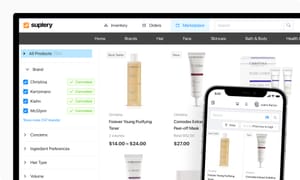How to sell beauty products to clients and not sound salesy
Loading the Text to Speech Player...
Are you struggling to sell your beauty products to clients without sounding too pushy or salesy? Of course, no one wants to sound like a used car salesman in their beauty salon.
I am ready to share with you some practical advice on how to sell your products to clients in a way that feels natural and non-intrusive. I'll cover everything from using the power of upselling and offering samples to finding a reliable manufacturer or supplier and planning different promotions. So, relax and get ready to learn how to increase your sales and keep your clients coming back for more!
Sales tips on how to sell beauty products to clients
Let me begin by sharing some practical tips that can help you enhance your sales while communicating with clients in a more natural and non-intrusive manner.
Good sales communication is a must for success in the beauty industry. In a report by HubSpot, 82% of customers said they would be more likely to buy from a company that gives them helpful and relevant content as they go through the buying process.
So, without further ado, let's dive into some of the best sales tips for selling beauty products to clients.
Skyrocket your salon’s profits!
Struggling to boost revenue? Our 50 service ideas PDF is packed with creative, high-impact services to fill your salon’s schedule — bank account. Download now to start earning more!
Oh no! We couldn’t subscribe you ☹️
Done! We've sent a link to your Email 📨
Be useful: suggest complementary products
Instead of trying to convince your clients to buy something they don't need or want, focus on understanding their beauty routine and suggesting products that complement their original purchase. For example, if a client is buying a new lipstick, you could suggest a matching lip liner or a lip scrub to prep their lips.
By ethically using the power of upselling, you can enhance your clients' experiences and satisfaction with your business. They will appreciate the added value and expertise you bring to their beauty routine, and you'll be able to increase your sales and profits at the same time.
Here are some examples of how you can use upselling to sell more beauty products:
- with a haircut, suggest a leave-in conditioner or styling product to help the client maintain the look at home
- with a facial service, suggest a toner or serum to target specific skin concerns
- with a pedicure, suggest a foot cream or cuticle oil to maintain the results and keep the client's feet soft and smooth
- with wax procedures, suggest a post-waxing lotion or serum to soothe and calm the skin
- with a manicure, suggest a hand cream or cuticle oil to keep their hands and nails looking healthy and moisturized
- with a massage, suggest a body lotion or aromatherapy oil to enhance the relaxation experience
Do not forget to explain why and how the product you suggest can help the client be beautiful. Remember that the goal is to give your clients suggestions that add value to their experience and make them happier with your business as a whole. Be sure sales will rise, and customer loyalty will be strengthened through this strategy.
Use your product expertise
Using your product expertise is a great way to sell more beauty products without sounding salesy. As a beauty professional, you have a unique insight into the products you use and recommend to your clients. So, you can use your knowledge to teach your clients about the benefits of certain products and how they can help them achieve their beauty goals. This will not only help your clients make informed decisions, but it will also build their trust in your recommendations and your business.
It's important to listen to your client's needs and recommend products that will work for them. Don't try to sell them products that they don't need or want. Instead, you should focus on making suggestions that are tailored to their skin type, hair type, or specific needs.
In addition, you can also use your product knowledge to demonstrate the products you're selling. This will give your clients a better understanding of how the products work and how they can benefit from using them. You can also give your clients samples or short treatments so they can try out the products before they buy them.
Offer samples
Giving out product samples is a good way to persuade clients to try beauty products without being too forceful. This allows clients to test the product before buying it.
There are some useful tips:
- The best time to offer product trials is after a salon treatment, like giving a moisturizer or serum after a facial. This shows you care about client needs.
- Special promotions or events are another way to offer samples, like giving a free small package with a product.
- One of the most common ways is to have trials available in-store for customers to try. You can have testers for your products set up or small sample sizes for customers to take home and try out.
- You can also offer samples online. This is a great way to reach customers who may not have a physical location nearby.
To get people to buy from you again and spread the word about your brand, you should put a high priority on being helpful and attentive when offering product trials. It's important to avoid being overly aggressive in the approach. By focusing on client's needs and offering the opportunity to try products firsthand, you can build trust and loyalty.
Marketing tips on how to sell beauty products to clients
The beauty market is projected to reach over $800 billion by 2025, and having a solid marketing strategy is key to standing out from the competition. Therefore, it's important to have marketing tips that build trust with your customers and drive sales without being overly salesy.
I'll tell you some marketing tips that have helped our clients sell more beauty products. So, let's dive in and make your beauty business shine!
Use social media reasonably and talk with your audience
As an expert, it's important to avoid looking like a traveling salesman who only shows up when there's something to sell. Instead, try to be there for your customers all the time as a consultant, editor, or even friend.
One way to do this is by regularly sharing valuable content and beauty tips, whether it's through conversations, blog posts, or social media. Engage with your audience by responding to their comments and questions and by offering advice on beauty routines and products.
By positioning yourself as a go-to expert in the beauty industry, you'll build trust and credibility with your customers, and they'll be more likely to turn to you when they need advice or are in the market for beauty products.
Remember to keep the balance between promotional and informative content. Too much promotion can turn off customers, while too much information without any promotion can leave potential sales on the table. Find the right positioning to keep your customers engaged while still generating sales.
By adopting a consultative approach, you can build long-lasting relationships with your customers, increase your sales, and become a trusted and valued member of their beauty routine.
Plan different promotions
Offer various promotions — it’s an effective strategy for increasing beauty product sales in a salon. In fact, studies show that promotions and incentives have a significant impact on customer behavior. RetailMeNot did a survey and found that 80% of customers are more likely to buy when there is a promotion.
Promotions can take many forms, including discounts, loyalty programs, bundle deals, and free samples. They are an excellent way to attract new customers, retain existing ones, and encourage repeat purchases.
If you need to create compelling promotions, it's essential to consider seasonal or holiday themes, special events, and customer needs. For example, during the summer months, a promotion could focus on sun care products, while in the winter, a discount could be offered for moisturizing skincare items.
Here are some more examples of promotions and special offers for you
- Bundle deals: Offer customers a bundle deal where they can purchase a combination of products at a discounted price. For example, you could offer a bundle of cleanser, toner, and moisturizer for a discounted price.
- Gift with purchase: Offer customers a free gift with the purchase of a certain product or dollar amount. For example, you could offer free lipstick with the purchase of $50 or more in products.
- Referral discounts: Encourage customers to refer their friends and family to your salon by offering them a discount on their next purchase. For example, offer customers 10% off their next purchase for each person they refer who makes a purchase.
- Social media contests: Host a social media contest where customers can enter to win a prize by sharing a photo of themselves using your products. For example, you could ask customers to share a photo of their favorite makeup look using your products and tag your salon to be entered to win a free makeup consultation.
- Loyalty programs: Offer customers a loyalty program where they can earn points for their purchases and redeem them for discounts or free products.
By planning different promotions throughout the year, a beauty business can keep customers engaged and encourage them to buy more beauty products.
Be flexible and try different things
Marketing trends in the beauty industry change faster than some people can change their lipstick shade, and it's important to keep up with the latest techniques to reach your target audience. That's why it's essential to be flexible and open-minded and not to be afraid of trying new things to promote your beauty products.
Be creative with your marketing strategies, try new ways of advertising, and don't be afraid to experiment with different approaches. May it be the time to start collaborating with beauty influencers or organize a giveaway on social media? Or is it a good time to offer a special discount for customers who refer friends to your salon? Be creative and think about new approaches.
Remember, every business is unique, and what works for one may not work for another. So, be open to trying new things and take note of what works for your clients. By being flexible and open to new marketing strategies, you'll not only grow your customer base but also keep your beauty business on the cutting edge of the industry.
Finding the right balance between sales and service is key to selling beauty products in a salon. By focusing on giving your customers a great experience and making sure your products meet their needs and wants, you can increase sales and profits while keeping your good name.
Don’t forget about buyers' expectations
To sell beauty products successfully, you need to meet the expectations of your customers. This means understanding what they want and need and tailoring your sales approach to meet those expectations. In other words, it's not about what you think they should buy, but what clients actually want to buy.
So, what do beauty buyers expect to see when they walk into your salon or browse your online store? Let's take a look at some key expectations and how you can meet them.
Here are a few things that beauty buyers are looking for:
- Quality: Customers want to know that the products they're buying are high-quality and will work well for them. For example, if a customer is looking for a moisturizer, they want to make sure that it will actually moisturize their skin and not leave it feeling greasy or oily.
- Effectiveness: Customers also want products that are effective and will help them achieve their beauty goals. For example, if a customer is looking for a product to reduce the appearance of fine lines and wrinkles, they want to be sure that it will actually work — social proof can deal with it.
- Affordability: While quality and effectiveness are important, customers also want to know that they're getting good value for their money. They don't want to spend a fortune on a product that doesn't work or that they can't afford to repurchase.
- Personalization: Customers want to feel like the products they're buying are tailored to their individual needs. For example, if a customer has sensitive skin, they want to know that the products they're buying are gentle and won't irritate their skin.
By keeping these things in mind, beauty business owners can ensure that they're offering the types of products that their customers are looking for. It's also important to stay up-to-date on the latest trends and innovations in the beauty industry so that you can offer new and exciting products that will keep your customers coming back.
Make sure to find a reliable brand or supplier
All the above makes no sense if you cannot guarantee the quality and effect. That is why finding a reliable supplier and choosing the best brand are the keys to success in selling beauty products. It's essential to remember that all the sales tips in the world won't make a difference if your product quality is not up to par or if you have issues with stock or availability.
For example, imagine that you're promoting a new skincare line to your clients. You've implemented a great sales strategy, you've created a beautiful display, and you're ready to start selling. But when your clients try the products, they're disappointed with the results. Word will quickly spread that your products don't work as advertised, and you'll lose business as a result.
On the other hand, even if your product is amazing, if you're constantly having issues with stock or availability, your clients will start to lose trust in the reliability of your services. They don't want to risk falling in love with a product that they won't be able to get in the future.
So, take the time to do your research and find a supplier or brand that you can trust. Look for someone with a good reputation in the industry who can provide consistent quality and reliable delivery. But if you do not want to spend time or are not sure that reviews on the internet are a credible source of information, look at Suplery. We already chose the best brands, checked them, and published the fullest product information on our platform. And much more than that, we have solved all the ordering and inventory issues.
Order products and manage inventory effortlessly with Suplery
Naturally, as a beauty business owner, you want to secure your business and ensure that the necessary products are always on hand. The answer to this challenge consists of ordering and inventory management.
In fact, ordering is the process of supplying your business with the necessary products and equipment. And it can be split into several stages:
Stage 1. Order planing. You must define what products and quantities will be needed in the next 1–3 months.
Stage 2. Order scheduling. Then, based on the need, you have to schedule the dates for supply.
Stage 3. Order placement. As soon as you know when you want the product to be delivered, you have to find a supplier, negotiate the price and quantities, and place an order.
Stage 4. Order check-up. Finally, you have to receive the order and check to see if you received everything you ordered and the condition and quality of the products.
Stage 5. Paperwork. Afterward, you must do all the paperwork, resolve payment issues, and do regular supplier reconciliations. of
All of these things take a lot of time, result in mistakes, and have supply issues when done manually. In most cases, beauty business managers fail to set up the process and do as it goes, trying to make orders on Wednesdays or when they run out of something.
And obviously, precise in-time orders are impossible without inventory management. This is the process of tracking and storing products. In a wider sense, it also includes planning and ordering. My experience shows that many businesses today still track all the products manually on a daily or weekly basis. They claim that it is highly time-consuming and demands long personal training, which still does not eliminate numerous mistakes and losses due to out-of-stocks.
This is where Suplery comes in: it's a powerful inventory management solution that can help you stay on top of your inventory and make informed decisions about which products to stock.
With Suplery, you'll be able to track your inventory levels easily, set up automatic reorder points, and receive alerts when it's time to restock. This means that you'll never run out of stock and risk losing sales.
Additionally, Suplery:
- Provides valuable insights into inventory and sales trends, allowing you to make data-driven decisions about which products to carry and how much to order
- Saves time and effort by automating inventory tracking and reordering processes
- Can improve the overall efficiency and profitability of your business
With Suplery, you'll be able to streamline your inventory management processes and focus on what really matters — providing your customers with high-quality beauty products that meet their needs.
So, put these tips into action and upgrade your inventory management system, and you'll be well on your way to selling beauty products to clients in a way that's natural, unobtrusive, and successful.
Start selling beauty products to clients easily
Streamline your inventory management processes with Suplery and focus on sales
Start now The latest articles and industry insights delivered to your inbox
The latest articles and industry insights delivered to your inbox
Subscribe to receive a monthly digest of our most valuable resources like blog posts, whitepapers, and guides.
Oh no! We couldn’t subscribe you ☹️
Done! You've subscribed 💛
Unsubscribe anytime. Your data is stored for business-to-business communication purposes. See our Privacy policy.
Last updated on Jan 19, 2025
“What Changed” in this article? Everything. It's packed with the latest findings, the ripest data, and a fresh analysis you won't find anywhere else.
A subject-matter expert wrote the content, and reliable, official sources support it. Recent research has been incorporated to maintain relevancy and accuracy.
Please share this post
Unlock the secrets to beauty business success!
Join our community for insider tips on product management, marketing, sales and client attraction. Elevate your business with expert insights delivered straight to your inbox.
Oh no! We couldn’t subscribe you ☹️
Done! You've subscribed 💛
Trusted by the best in the beauty industry.
Transform your beauty business with Suplery!
Already enjoying our expert tips? Take the next step and join Suplery to revolutionize your business operations.
Huge range of professional products
One-click checkout after first order
Automated predictive orders
Seamless inventory management
From words to action
Start working with Suplery and explore all the tools and services you need to expand your business
Get started with Suplery24/7 Support
Secure payments
Designed by industry’s experts




